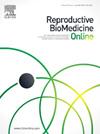高CD16-NKp46bright子宫内膜自然杀伤细胞可能预测复发性生殖失败妇女的妊娠成功。
IF 3.7
2区 医学
Q1 OBSTETRICS & GYNECOLOGY
引用次数: 0
摘要
研究问题:CD16-NKp46bright子宫内膜自然杀伤(uNK)细胞是否可以作为未知复发性生殖衰竭(URRF)妇女妊娠成功的预测因子,其潜在机制是什么?设计:一项前瞻性研究,涉及63名患有URRF的女性,随访2年。年龄调整后,怀孕组和非怀孕组均有17名妇女。孕妇组进一步分为活产组(n = 10)和流产组(n = 4),其中3名妇女未随访。用多色流式细胞术分析uNK细胞表面抗原的表达和细胞因子的产生。结果:表达NKp46 + uNK (P = 0.034),NKp46bright uNK (P = 0.045),CD16-NKp46bright uNK (P = 0.026),NKp46brightNKG2D + uNK (P = 0.004)和NKp46 + NKG2D + uNK (P = 0.037)细胞在没有怀孕组相比显著降低怀孕。活产组CD16-NKp46bright uNK细胞的表达明显高于未妊娠组(P = 0.040)。CD16-NKp46bright uNK细胞的阈值为44.9%,曲线下面积最大。CD16-NKp46bright uNK细胞(CD56+ uNK细胞中+IFN-γ+ (P = 0.014)和CD56bright uNK细胞中+IFN-γ+ (P = 0.013)和CD56+ uNK细胞中TNF-α-IFN-γ- (P = 0.039)和CD56bright uNK细胞中(P = 0.017)显著降低的妇女,未能实现活产或妊娠的风险较高(or 21.60, 95% CI 2.14至218.58;P = 0.004 (OR 11.20, 95% CI 2.20 ~ 56.93; = 0.005页)。结论:CD16-NKp46bright uNK细胞是一种保护因子,也是预测URRF妊娠成功的合适候选细胞。本文章由计算机程序翻译,如有差异,请以英文原文为准。
Higher CD16-NKp46bright uterine endometrial natural killer cells may predict pregnancy success in women experiencing recurrent reproductive failure
Research question
Could CD16-NKp46bright uterine endometrial natural killer (uNK) cells serve as a predictor of pregnancy success in women with unknown recurrent reproductive failure (URRF), and what are the underlying mechanisms involved?
Design
A prospective study involving 63 women with URRF, followed up for 2 years. After age adjustment, 17 women remained in both the pregnant and non-pregnant groups. The pregnant group was further divided into the live birth (n = 10) and miscarriage (n = 4) groups, with three women lost to follow-up. Surface antigens expressed and cytokine produced in uNK cells were analysed with multicolour flow cytometry.
Results
Expression NKp46+ uNK (P = 0.034), NKp46bright uNK (P = 0.045), CD16-NKp46bright uNK (P = 0.026), NKp46brightNKG2D+ uNK (P = 0.004) and NKp46+NKG2D+ uNK (P = 0.037) cells was significantly lower in the non-pregnant group compared with the pregnant group. Also, the expression of CD16-NKp46bright uNK cells was significantly (P = 0.040) higher in the live birth group compared with the non-pregnant group. The threshold 44.9% of CD16-NKp46bright uNK cells showed the largest area under the curve. Women with decreased CD16-NKp46bright uNK cells (<44.9%), produced significantly higher TNF-α+IFN-γ+ in CD56+ uNK (P = 0.014) and in CD56bright uNK cells (P = 0.013) and significantly lower TNF-α-IFN-γ- in CD56+ uNK (P = 0.039) and in CD56bright uNK cells (P = 0.017), and had an elevated risk of failing to achieve live birth or pregnancy (OR 21.60, 95% CI 2.14 to 218.58; P = 0.004 (OR 11.20, 95% CI 2.20 to 56.93; P = 0.005).
Conclusions
CD16-NKp46bright uNK cells are a protective factor as well as an appropriate candidate for predicting pregnancy success in URRF.
求助全文
通过发布文献求助,成功后即可免费获取论文全文。
去求助
来源期刊

Reproductive biomedicine online
医学-妇产科学
CiteScore
7.20
自引率
7.50%
发文量
391
审稿时长
50 days
期刊介绍:
Reproductive BioMedicine Online covers the formation, growth and differentiation of the human embryo. It is intended to bring to public attention new research on biological and clinical research on human reproduction and the human embryo including relevant studies on animals. It is published by a group of scientists and clinicians working in these fields of study. Its audience comprises researchers, clinicians, practitioners, academics and patients.
Context:
The period of human embryonic growth covered is between the formation of the primordial germ cells in the fetus until mid-pregnancy. High quality research on lower animals is included if it helps to clarify the human situation. Studies progressing to birth and later are published if they have a direct bearing on events in the earlier stages of pregnancy.
 求助内容:
求助内容: 应助结果提醒方式:
应助结果提醒方式:


